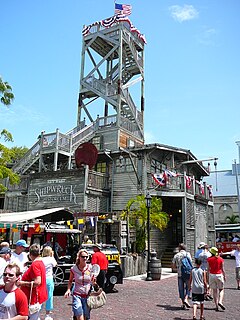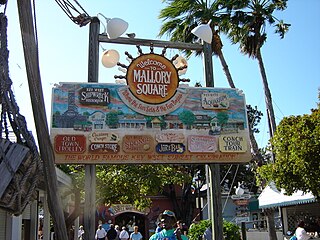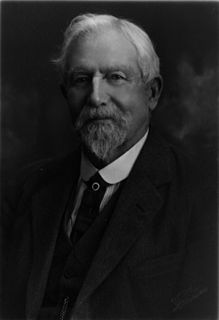Wrecking is the practice of taking valuables from a shipwreck which has foundered or run aground close to shore. Often an unregulated activity of opportunity in coastal communities, wrecking has been subjected to increasing regulation and evolved into what is now known as marine salvage.

Scapa Flow is a body of water in the Orkney Islands, Scotland, sheltered by the islands of Mainland, Graemsay, Burray, South Ronaldsay and Hoy. Its sheltered waters have played an important role in travel, trade and conflict throughout the centuries. Vikings anchored their longships in Scapa Flow more than a thousand years ago. It was the United Kingdom's chief naval base during the First and Second World Wars, but the facility was closed in 1956.

Asa Gray is considered the most important American botanist of the 19th century. His Darwiniana was considered an important explanation of how religion and science were not necessarily mutually exclusive. Gray was adamant that a genetic connection must exist between all members of a species. He was also strongly opposed to the ideas of hybridization within one generation and special creation in the sense of its not allowing for evolution. He was a strong supporter of Darwin, although Gray's theistic evolution was guided by a Creator.

Nuestra Señora de Atocha was a Spanish treasure galleon and the most widely known vessel of a fleet of ships that sank in a hurricane off the Florida Keys in 1622. At the time of her sinking, Nuestra Señora de Atocha was heavily laden with copper, silver, gold, tobacco, gems, and indigo from Spanish ports at Cartagena and Porto Bello in New Granada and Havana, bound for Spain. The Nuestra Señora de Atocha was named for a holy shrine in Madrid, Spain. It was a heavily armed Spanish galleon that served as the almirante for the Spanish fleet. It would trail behind the other ships in the flota to prevent an attack from the rear.

Rear Admiral Sir Home Riggs Popham, KCB, KCH, was a Royal Navy commander who saw service against the French during the Revolutionary and Napoleonic Wars. He is remembered for his scientific accomplishments, particularly the development of a signal code that was adopted by the Royal Navy in 1803.

HMS Agamemnon was a 64-gun third-rate ship of the line of the British Royal Navy. She saw service in the American Revolutionary War, French Revolutionary and Napoleonic Wars, and fought in many of the major naval battles of those conflicts. She is remembered as being Nelson's favourite ship, and was named after the mythical ancient Greek king Agamemnon, being the first ship of the Royal Navy to bear the name.

Reap the Wild Wind is a 1942 American adventure film produced and directed by Cecil B. DeMille and released by Paramount Pictures. It stars Ray Milland, John Wayne, and Paulette Goddard in the leading roles, and features Raymond Massey, Robert Preston, Lynne Overman, and Susan Hayward in supporting roles. DeMille's second Technicolor production, the film is based on a serialized story written by Thelma Strabel in 1940 for The Saturday Evening Post.

HMS Royal George was a ship of the line of the Royal Navy. A first-rate with 100 guns on three decks, she was the largest warship in the world at the time of her launch on 18 February 1756. Construction at Woolwich Dockyard had taken ten years.

John Cole "Jack" Reedman was a leading Australian sportsman of the late nineteenth and early twentieth century.
CSS Louisiana was a casemate ironclad of the Confederate States Navy built to aid in defending the lower Mississippi River from invasion by the Union Navy during the American Civil War. She took part in one major action of the war, the Battle of Forts Jackson and St. Philip, and when that ended disastrously for the Confederacy, she was destroyed by her crew.

The Ernest Hemingway House was the residence of American writer Ernest Hemingway in the 1930s. The house is situated on the island of Key West in Florida. It is at 907 Whitehead Street, across from the Key West Lighthouse, close to the southern coast of the island. Due to its association with Hemingway, the property is the most popular tourist attraction in Key West. It is also famous for its large population of so-called Hemingway cats, many of which are polydactyl.

Nelson Tift was an American jurist, businessman, sailor, and politician who is best known for founding the city of Albany, Georgia.

USS Goldfinch (AMS-12/YMS-306) was a YMS-1-class minesweeper of the YMS-135 subclass acquired by the U.S. Navy for the dangerous task of removing mines from minefields laid in the water to prevent ships from passing.

The Key West Shipwreck Museum is located in Key West, Florida, United States. It combines actors, films and actual artifacts to tell the story of 400 years of shipwreck salvage in the Florida Keys. The museum itself is a re-creation of a 19th-century warehouse built by wrecker tycoon Asa Tift. Many of the artifacts on display are from the 1985 rediscovery of the wrecked vessel Isaac Allerton, which sank in 1856 on the Florida Keys reef and turned out to be one the richest shipwrecks in Key West's history, having resulted in the Federal Wrecking Court's largest monetary award for the salvage of a single vessel. Also included are relics from Spanish galleons, including a silver bar salvaged from the Nuestra Senora de las Maravillas that guests are encouraged to try to lift.

Mallory Square is a plaza located in the city of Key West, Florida, U.S.

Sir Arthur Dudley Dobson was a pioneer surveyor, engineer and explorer in New Zealand. Born in London, he came to Lyttelton, New Zealand, in 1850 on one of the First Four Ships. He is best known for taking the first party of Europeans over Arthur's Pass.

CSS Mississippi was a projected ironclad warship of the Confederate States Navy, intended to be used on the Mississippi River in the vicinity of New Orleans during the American Civil War. Her design was unusual, as she was built according to house-building techniques. Whether this would have proved to be feasible cannot be known, as she was not complete when New Orleans fell to the Union Fleet under Flag Officer David G. Farragut on 25 April 1862. Rather than let her fall into enemy hands, Captain Arthur Sinclair, CSN, ordered her to be hastily launched and burned. Despite the delays in construction that left her unfinished and untried, her mere existence, together with that of CSS Louisiana, raised thwarted hopes in the defenders of New Orleans, and unfounded fears in Union circles, that affected the strategy of both sides in the campaign on the lower Mississippi. Mississippi is significant to the Civil War therefore not so much as a warship as in the way her reputation influenced events, and as an example of the difficulties the South had in the contest with the industrial North.
George Edmund Byron Bettesworth was a British Naval Officer. During his service he participated in a notable single ship action, and had been wounded 24 times, which is probably a record.

Vice-Admiral Horatio Nelson, 1st Viscount Nelson, 1st Duke of Bronté,, also known simply as Admiral Nelson, was a British flag officer in the Royal Navy. His inspirational leadership, grasp of strategy, and unconventional tactics brought about a number of decisive British naval victories during the French Revolutionary and Napoleonic Wars. He is widely regarded as one of the greatest naval commanders in history.
















